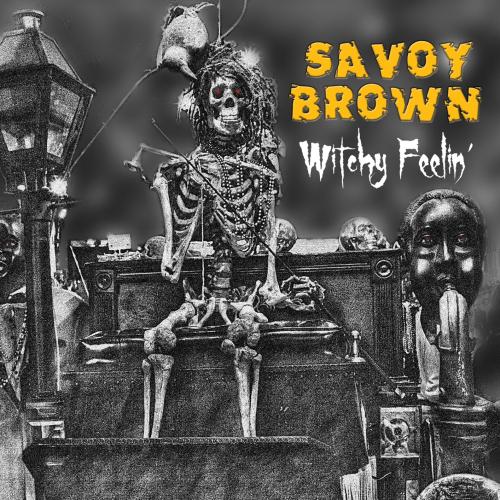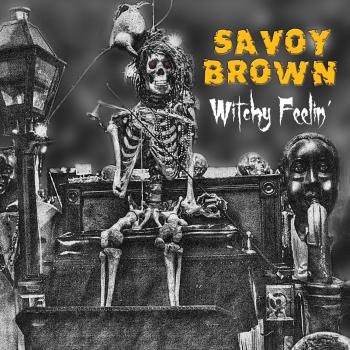
Witchy Feelin´ Savoy Brown
Album info
Album-Release:
2017
HRA-Release:
18.08.2017
Album including Album cover
I`m sorry!
Dear HIGHRESAUDIO Visitor,
due to territorial constraints and also different releases dates in each country you currently can`t purchase this album. We are updating our release dates twice a week. So, please feel free to check from time-to-time, if the album is available for your country.
We suggest, that you bookmark the album and use our Short List function.
Thank you for your understanding and patience.
Yours sincerely, HIGHRESAUDIO
- 1 Why Did You Hoodoo Me 05:13
- 2 Livin´On The Bayou 05:59
- 3 I Can´t Stop The Blues 05:25
- 4 Witchy Feelin´ 04:36
- 5 Guitar Slinger 03:51
- 6 Vintage Man 03:07
- 7 Standing In A Doorway 05:39
- 8 Memphis Blues 04:12
- 9 Can´t Find Paradise 04:28
- 10 Thunder, Lightning & Rain 07:54
- 11 Close to Midnight 04:08
Info for Witchy Feelin´
Blues is not for the faint-hearted. Since the genre first drew breath, its greatest practitioners have embraced the darkness, spinning tales of hardship and death, hellhounds and devilry. If the sleeve of Witchy Feelin’ suggests that Kim Simmonds, too, has a tendency towards the macabre, then Savoy Brown’s iconic leader is happy to confirm it. “Blues has always dealt with themes of the Devil, witchcraft and so forth, and I’ve always written along those lines. At least three of the songs on Witchy Feelin’ have that hoodoo vibe…”
Released in 2017 on Ruf Records, Witchy Feelin’ proves the Devil still has all the best tunes. From the thrillingly brittle guitar riff that opens Why Did You Hoodoo Me, we are in the hands of a master, with Simmonds reigniting the seismic vocals and searing fretwork that established Savoy Brown as linchpins of the ’60s British blues boom. “On this album, I tried my best to get my voice in its power zone,” he explains. “I’m a baritone singer. I like listening to singers I can relate to, such as J.J. Cale, Mark Knopfler, Tony Joe White and Tom Rush. For my guitar playing, I still get inspiration from Otis Rush, Buddy Guy and all the Chicago players I grew up listening to back in ’63… but I always listen to new music too.”
Recording alongside Pat Desalvo (bass), Garnet Grimm (drums) and engineer Ben Elliott, Simmonds leads us into a world of dark nights, wild weather, women and whiskey: all perennial themes given a modern twist by this ageless bluesman. “The songs on this album have been two years in the making,” he reflects. “I tried to write songs that had a personal point of view yet can be relatable to everyone. On Vintage Man, I wrote about being the type of guy who doesn’t change as he gets older. I wrote about the power of love on Why Did You Hoodoo Me. And with Guitar Slinger, I wrote a song about seeing a great guitar player in an old country bar – as I did when I first saw Roy Buchanan in ’69.”
Anyone who witnessed Savoy Brown leave the blocks in 1965 would speak of a similar epiphany. Back then, the band were the spark that ignited the blues-boom, signing to Decca, opening for Cream’s first London show and boasting a lead guitarist who was being namedropped in the same reverential breath as peers like Clapton and Hendrix (with whom Simmonds jammed). Already, the guitarist was emerging as the band’s driving force. “I had a vision,” he reflects. “When I started the band back in 1965, the concept was to be a British version of a Chicago blues band. And the exciting thing now is, that vision is still alive.”
Soon, Savoy Brown had achieved what most British bands never did – success in America – and became a major US draw thanks to their high-energy material and tireless work ethic. “There’s far too much said about sex, drugs and rock ‘n’ roll,” Simmonds told Classic Rock. “It’s a cliché. We were all extremely hard-working guys. When we came over to America, we were like a little army. I look at that time as being filled with incredible talent.”
Times changed, of course, and by 1979, Simmonds had moved from a London he no longer recognised – “The punks were everywhere!” – to settle permanently in New York. The Savoy Brown bandmembers came and went, and the music scene shifted around him, but the guitarist stuck thrillingly to his guns and reaped the rewards, performing in iconic venues like Carnegie Hall and the Fillmore East and West, releasing thirty-odd albums, and later enjoying a well-deserved induction into Hollywood’s Rock Walk Of Fame.
Even in the post-millennium, while his peers grow soft and drift into semi-retirement, Simmonds retains a vision and an edge, spitting out acclaimed albums that include 2011’s Voodoo Moon, 2014’s Goin’ To The Delta, 2015’s The Devil To Pay – and the emphatic new addition to Savoy Brown’s catalogue, Witchy Feelin’. “I'm amazed that I still have the energy inside me to play guitar, create music and write songs,” he considers. “I’ve been blessed in my life and I thank God for that. I’ve never been a believer in holding on to the past – I don’t look over my shoulder and congratulate myself. I always want to climb the next mountain – and I’m very pleased with this new album…”
Kim Simmons, guitar, vocals
Pat DeSalvo, bass
Garnet Grimm, drums
Savoy Brown
Legendary .... a blues/rock institution .... true innovators. These are just a few of the ways Savoy Brown has been described over the past 47 years by music critics and fans.
One of the earliest of British blues bands, with founder guitarist Kim Simmonds at the helm, Savoy Brown helped launch the 1967 UK blues boom movement that brought blues music back to the USA and invigorated the style from then on. In the process, the band became part of the framework that launched the rock and roll music of the 1970’s. Their influence now stretches into modern rock as we know it today.
The band recorded their first singles for Mike Vernon’s Purdah label in 1966 and quickly followed up with the landmark album “Shakedown”. Singer Chris Youlden joined the band in 1968 and many classic records appeared, with songs such as “I’m Tired” and “Louisiana Blues” becoming radio staples. Blues-rock and boogie music always was the band’s calling card and they captured, forever, the spirit of the music on the live side of “A Step Further” (1969) with a twenty-minute boogie “The Savoy Brown Boogie” dedicated to fans in Detroit.
By 1971, Youlden had departed on a solo career and band members Dave Peverett, Roger Earle, and Tony Stevens left to form their own group, Foghat.
Kim Simmonds rebuilt the band using former members of the blues band Chicken Shack and vocalist Dave Walker. That year, “Street Corner Talking” brought the band its best chart success up to that date. “Tell Mama”, “Street Corner Talking”, “All I Can Do Is Cry” and the band’s funky re-make of the Motown classic, “I Can’t Get Next To You”, took the band to platinum status and placed them in front of wildly enthusiastic rock audiences in arenas all over the world.
After the successful run of the early to mid 70's, Kim moved operations to the USA and continued making the kind of records he wanted to make with a succession of line-ups. Records as diverse as the acoustic blues “Slow Train" to the hard-hitting "Rock And Roll Warriors" appeared. All were eagerly accepted by the fans.
A three record deal with Crescendo in 1987 took the band into more of a rock direction, with records such as "Live 'n' Kicking" placing the group in a live setting, where they've always excelled.
In the '90's, "Let It Ride" was released. Kim enlisted Pete McMahon for vocal and harmonica duties in 1994 and added ex-Robert Cray drummer Dave Olsen to record "Bring It Home" for Viceroy. This set the tone for the next five years.
Nathaniel Peterson was brought in to handle bass playing and singing in the late 1990s. After touring the world extensively for three years, "The Blues Keep Me Holding On” was released in 1999 by Mystic Music. This modern blues record brought the band's epic music journey full circle.
With new goals in mind, Kim Simmonds took over vocal duties in 2001, leading to the 2003 release, "Strange Dreams", on Blind Pig Records. This was a hit with critics, and fans alike. Kim, as front man vocalist, fit the times perfectly. Changing into a three piece classic blues/rock outfit in 2006 and still doing double duty as guitarist and vocalist, Kim released the bands 30th album “Steel.”
In 2009, after nearly a decade of singing lead vocals, but wanting to concentrate again on his guitar playing, Simmonds brought in Joe Whiting as lead singer. The band thus became a four-piece aggregation with Garnet Grimm on drums and Pat DeSalvo playing bass. The new changes coincided with the release of a retrospective album “Too Much of a Good Thing” that covered the years 1992-2007.
The year 2011 brings the release of "Voodoo Moon" (November, Ruf Records) with this album showing good early sales, and reviews, to date.
The year 2012 sees Joe Whiting leaving the band late in the year.
The year 2013 likely brings a new album and the release of a live CD/DVD package recorded in Germany during May 2012.
So, from London’s Soho night clubs in 1966 to headlining the world’s most famous venues (Carnegie Hall, Fillmore’s East and West, Cobo Hall, etc.), you have Savoy Brown doing it all. The band continues to tour worldwide and they give a glimpse into the past, but also inspire new listeners with their personal brand of rocking boogie, blues and rock.
This album contains no booklet.







